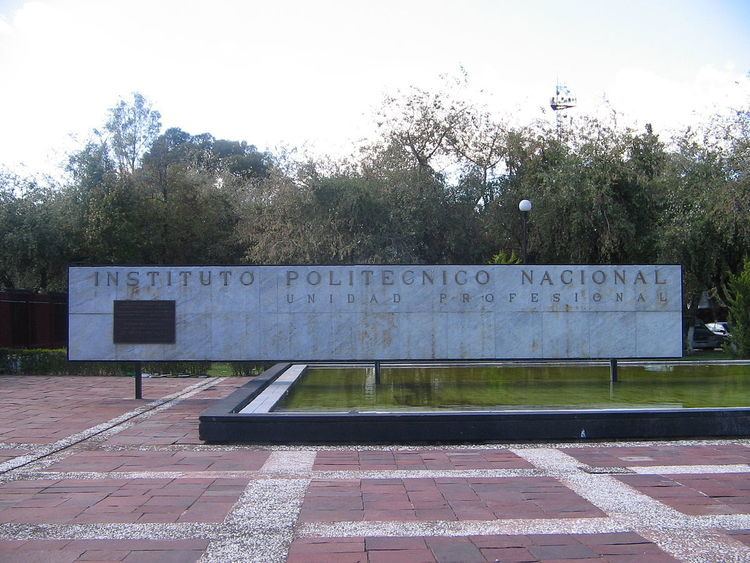Type Public Dean Jesús Ávila Galinzoga Phone +52 55 5729 6000 Mascot White Donkey | Established 1 January 1936 Academic staff 17,534 Colors White, Maroon | |
 | ||
Motto La Técnica al Servicio de la Patria Motto in English Technology to meet the needs of the Nation Address s/n, de, Av Instituto Politécnico Nacional, Lindavista, Nueva Industrial Vallejo, 07738 Ciudad de México, Mexico Director Enrique Fernández Fassnacht Notable alumni Ernesto Zedillo, Guillermo González Camarena, Josefina Vázquez Mota, Pedro Rudomín Zevnovaty, Jerzy Rzedowski Similar National Autonomous University, Universidad Autónoma Metropolitana, Unidad Profesional Interdisci, CINVESTAV, ESIQIE Profiles | ||
Instituto polit cnico nacional
The Instituto Politécnico Nacional ([instiˈtuto poliˈtekniko nasjoˈnal], National Polytechnic Institute), abbreviated IPN, is one of the largest public universities in Mexico with 171,581 students at the high school, undergraduate and postgraduate levels. It was founded on 1 January 1936 during the administration of President Lázaro Cárdenas del Río as a response to provide professional education to the most disadvantaged social classes in that period, a practice that is maintained because it is one of the few vocational schools in the world.
Contents
- Instituto polit cnico nacional
- History
- Organization
- Academics
- Athletics
- Scientists and technologists
- Politicians
- Notable faculty
- References
The institute consists of 98 academic units offering 293 courses of study. It includes 78 technical careers, 80 undergraduate and 135 postgraduate programs. Its main campus, called 'Unidad Profesional Adolfo López Mateos' or 'Zacatenco', is on approximately 530 acres (2.1 km2) north Mexico City.
The IPN is based primarily in Mexico City and its suburbs, but with several research institutes and facilities distributed over 22 states.
History
The institute was founded on January 1, 1936 during the administration of President Lázaro Cárdenas in what had been previously known as the Ex hacienda Santo Tomás — a large estate initially owned by Spanish conquistador Hernán Cortés in the 16th century and donated by the federal government.
Prominent astronomer Luis Enrique Erro, former revolutionary Juan de Dios Bátiz Paredes and former minister of education Narciso Bassols were among its initial promoters.
During the administration of former director Alejo Peralta sufficient lands were given to IPN. Expropriated lands of Santa Maria Ticomán (213 ha) and San Pedro Zacatenco (43 ha) were used.
The construction of what is now the Professional Unit "Adolfo López Mateos" (Zacatenco) began in 1958. In 1959, former President Adolfo López Mateos, the former minister of education Jaime Torres Bodet, and former director of IPN Eugenio Mendez Docurro, inaugurated the first four buildings of Zacatenco, which were occupied by the Superior School of Mechanical and Electrical Engineering (ESIME) and the Superior School of Engineering and Architecture (ESIA).
Organization
The institute is organized around 98 academic units including 18 vocational high schools (operates as CECyT), 26 university colleges, 20 scientific and technical research centers, 17 continuing education centers, 4 units for educational support, 3 support units for education innovation, 8 support units for research, development and technological and enterprise foment, and 2 units affiliated to science, enterprise research and development.
These schools are primarily in Mexico City, although several extension and research facilities are distributed over 22 states.
Some units (particularly the semi-autonomous, internationally renowned CINVESTAV) enjoy a high degree of academic and budgetary freedom. The institute as a whole is headed by a director-general appointed by the President of Mexico, usually (but not always) after some consultation with members of its academic community. Since November 2014, its director-general is Enrique Fernández Fassnacht.
In addition to its academic endeavors, and as part of its cultural promotion strategy, the institute operates 'Canal Once', the oldest public broadcast service in Latin America featuring original cultural, scientific, information and entertainment programming, foreign shows and classic, rare, and non-commercial films from all over the world.
Academics
The Institute offers 80 undergraduate programs leading to four- or five-year bachelor's degrees and 135 postgraduate programs leading to 29 postgraduate diplomas, 70 master's degrees and 36 doctorate degrees.
Like most public universities in Mexico, in addition to its undergraduate and graduate schools the institute sponsors several vocational high schools called 'Centros de Estudios Científicos y Tecnológicos' (C.E.C. y T.), most of which are in Greater Mexico City. Upon completion, they lead to a technician degree. For this level of study, the institute offers 78 technical careers.
Athletics
IPN fields 27 varsity teams in sports or activities such as archery, American football, athletics, baseball, basketball, body building, bowling, boxing, chess, cycling, frontenis, gymnastics, handball, indoor soccer, judo, karate, kendo, mountaineering, rowing, soccer, swimming, taekwondo, tennis, touch football, volleyball, weightlifting and wrestling.
The university maintains a fierce rivalry with all the athletic teams from the National Autonomous University of Mexico but have a particularly bitter competition with its football program, the "Pumas Dorados" (Golden Pumas).
